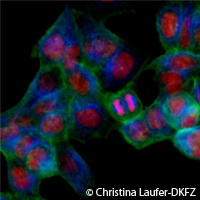Genes mimic Facebook workings
Genes interfere with each other in the same manner that the social network Facebook suggests friends, according to research published in the online version of Nature Methods. The study was funded in part by the CANCERPATHWAYS ('Developmental molecular pathways in Drosophila as a model for human cancer') project, which is backed with EUR 3 million under the Health Theme of the EU's Seventh Framework Programme (FP7). CANCERPATHWAYS brings together experts from Germany, Spain, Hungary, Austria and the UK. Scientists at the European Molecular Biology Laboratory (EMBL) and the German Cancer Research Centre (DKFZ) in Heidelberg in Germany have developed a method to uncover the combined effects of genes. The method should help scientists understand how different genes can amplify, cancel out or mask the effects of each other. If two people have many friends in common on Facebook, the odds are that those two people know each other - even if they themselves are not Facebook friends, commented lead scientists Wolfgang Huber from EMBL and Michael Boutros from DKFZ. Likewise, they said that genes that have similar genetic interaction profiles are likely to influence each other's effects. According to Dr Huber and Professor using Boutros their new method, scientists can now suggest such 'friends', namely genes that are likely to affect the same cellular processes. In the long run, this could help predict patient outcomes and adapt treatments for diseases such as cancer, according to the research team. To understand the connections between genetic make-up and traits like disease susceptibility, scientists have frequently consulted genome-wide association studies, in which they compare genetic variants of people with a particular disease to those of healthy people. Such studies have linked many genes to diseases, but these links were often weak and not clear-cut, possibly because individual genes often do not act alone, said the research team. The effects of a particular gene can depend on what other genes a person carries, and the new method developed by Dr Huber and Professor Boutros at DKFZ enables scientists to uncover and measure those combined effects. As the scientists wrote in their paper in Nature Methods, 'the analysis of synthetic genetic interaction networks can reveal how biological systems achieve a high level of complexity with a limited repertoire of components. Studies in yeast and bacteria have taken advantage of collections of deletion strains to construct matrices of quantitative interaction profiles and infer gene function. Yet comparable approaches in higher organisms have been difficult to implement in a robust manner'. In this new study, the scientists took a set of genes that are important for cell signalling and, using a technique called RNA interference (RNAi), silenced those genes two at a time, and compared the effect to what happens when only one or the other member of each pair is silenced. In so doing, they were able to identify a new component in a cell-signalling process known as the Ras pathway, which is involved in cellular proliferation, and is known to go awry in tumour cells. 'Here we assessed the combined phenotypes of all pairwise RNAi treatments through eight independent measurements, including all possible combinations of two RNAi reagents for both target genes,' they explained in their paper. 'Different mathematical definitions have been proposed for genetic interactions. We applied the most commonly used approach, deviation from multiplicativity.' The researchers said that this approach 'allowed us to identify sparse networks of interacting genes substantially enriched in known interaction pairs, indicating that the model is appropriate to infer biologically meaningful interactions from the observed phenotypic features'. They concluded that 'the robust experimental design and stringent statistical analysis provides a framework for studies in other model system, including human cells'.For more information, please visit: European Molecular Biology Laboratory (EMBL): http://www.embl.de/ Nature Methods: http://www.nature.com/nmeth/index.html
Countries
Austria, Germany, Spain, Hungary, United Kingdom



